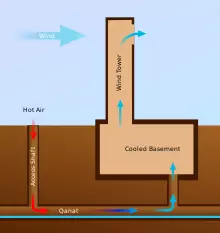 Image source: sanaulac.vn
Image source: sanaulac.vn
An evaporative cooler, also known as an evaporative air conditioner, swamp cooler, swamp box, desert cooler, or wet air cooler, is a device that cools air through the evaporation of water. Unlike traditional air conditioning systems, which use vapor-compression or absorption refrigeration cycles, evaporative cooling relies on the fact that water absorbs a significant amount of heat when it evaporates. This allows evaporative cooling to cool air using much less energy than refrigeration.
Evaporative cooling is particularly beneficial in extremely dry climates, as it not only cools the air but also adds moisture to it, providing a more comfortable environment for building occupants. Additionally, in arid climates, evaporative cooling can significantly reduce energy consumption and the need for expensive compressor-based cooling equipment.
A Brief History
Evaporative cooling has been used since ancient times, with early examples including windcatchers in ancient Egypt and Persia, which caught the wind and passed it over subterranean water to cool indoor spaces. Modern advancements in evaporative cooling technology can be attributed to inventors and researchers like William H. Goettl and Baruch Givoni, who developed innovative cooling systems and design guidelines in the 20th century.
How It Works
Evaporative coolers lower air temperature by using the principle of evaporative cooling, which involves the conversion of liquid water into vapor using the thermal energy in the air. This process results in a decrease in air temperature and an increase in humidity. Evaporative cooling is most effective in dry climates, where the relative humidity is low. The cooling potential of evaporative cooling depends on the wet-bulb depression, which is the difference between the dry-bulb temperature and the wet-bulb temperature.
 Image source: sanaulac.vn
Image source: sanaulac.vn
Types of Evaporative Cooling
There are different types of evaporative cooling systems, including direct evaporative cooling, indirect evaporative cooling, and two-stage evaporative cooling.
-
Direct Evaporative Cooling: In this type of system, warm dry air is passed through wetted pads, where it is cooled by the evaporation of water. The cooled air is then circulated into the building. Direct evaporative cooling systems are simple and cost-effective, but they increase humidity levels, making them less suitable for humid climates.
-
Indirect Evaporative Cooling: Indirect evaporative cooling involves cooling air indirectly by using a heat exchanger to transfer the cool energy to the supply air. The cooled air never comes in direct contact with the conditioned supply air, preventing humidity increase. Indirect evaporative cooling is more suitable for hot-humid climates where increasing indoor humidity is not desirable.
-
Two-Stage Evaporative Cooling: Two-stage evaporative cooling combines both direct and indirect cooling methods. In the first stage, air is pre-cooled indirectly without adding humidity. In the second stage, the pre-cooled air passes through wet pads and picks up humidity as it further cools. This two-stage process enables the system to achieve cooler air with reduced humidity levels, providing enhanced comfort.
Advantages and Disadvantages
Evaporative cooling offers several advantages over traditional air conditioning systems:
-
Cost-effectiveness: Evaporative coolers are less expensive to install and operate compared to traditional refrigeration-based air conditioning systems. They consume less energy and do not require costly refrigerants.
-
Ease of Installation and Maintenance: Evaporative coolers can be installed and maintained by mechanically inclined users, reducing the need for professional assistance. The mechanical components, such as fans and water pumps, are easy to repair or replace.
-
Ventilation Air: Evaporative coolers provide high volumes of fresh air, promoting better indoor air quality and decreasing the "age-of-air" in the building. They also introduce moisture, which can be beneficial in dry climates.
-
Water Efficiency: Evaporative coolers use water as their working fluid, consuming less water than traditional cooling towers used in refrigeration systems. However, water usage and maintenance are essential considerations.
Despite these advantages, evaporative cooling has some limitations:
-
Performance in High Humidity: Evaporative coolers are not as effective in areas with high humidity levels. The cooling capacity decreases, and the increase in humidity may cause discomfort and promote mold and bacteria growth.
-
Health Hazards: Improperly maintained evaporative coolers can become breeding grounds for mosquitoes and can disperse mold and bacteria into the air, potentially causing health issues. Regular cleaning and maintenance are necessary to prevent these hazards.
-
Maintenance Frequency: Evaporative coolers require regular maintenance, including the replacement of evaporative media and cleaning of mechanical components. Water quality and mineral deposits should also be monitored.
Evaporative cooling is a viable and efficient alternative for cooling air, especially in arid and dry climates. Its cost-effectiveness, ease of installation, and ventilation benefits make it an attractive option for residential and industrial applications. However, careful consideration of water usage, maintenance requirements, and performance limitations in high humidity areas is necessary for optimal performance and safety.

















